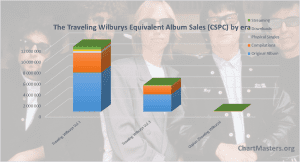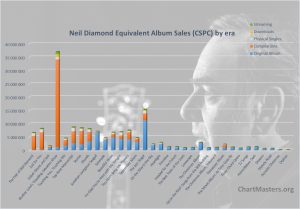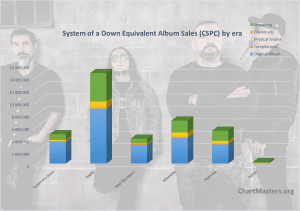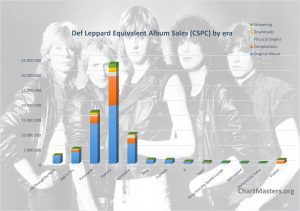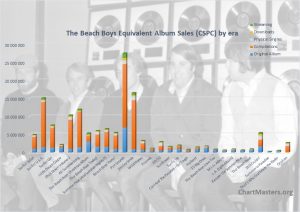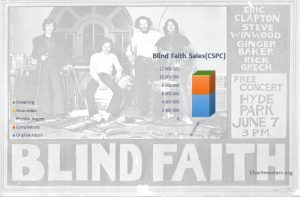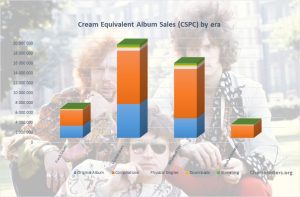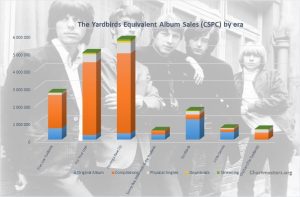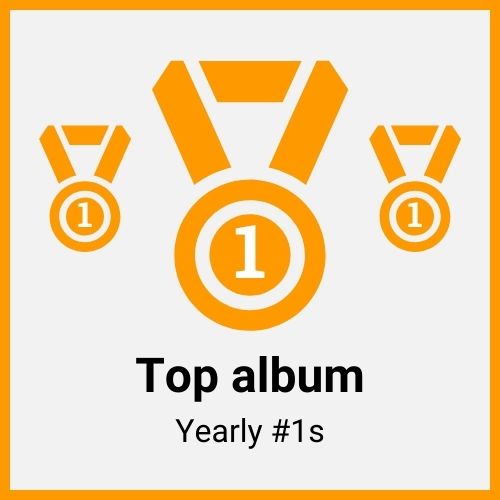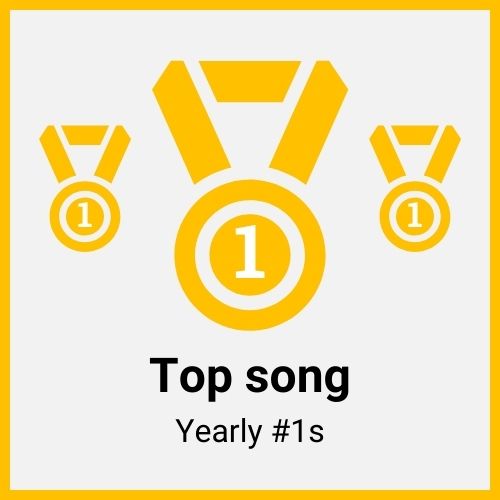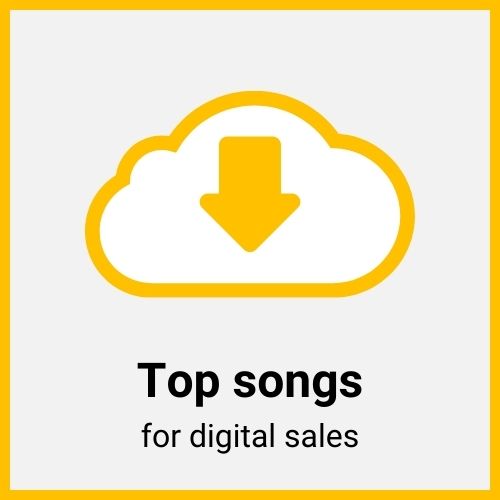Led Zeppelin albums and songs sales
Few bands embody the late sixties and early seventies like Led Zeppelin do. But apart from firmly belonging to their time, this four-piece group not only became one of the biggest of all time but also, most importantly, sustained a huge level of success during the following decades. Part of that can be seen by how they were outsold by other hard rock groups in some key markets back in the day and how they eventually crushed the same bands at some later point.
It may sound doubtful that Led Zeppelin went from Deep Purple-like popularity to Pink Floyd-like status. If you wonder if this is a reality of Medias exaggeration, you will have your answer within’ the next few pages.
Overall, they released 8 studio albums plus a bootleg, Coda, that is often regarded as part of their essential discography, with the most successful and long-lasting appealing one being, of course, being their fourth title with sales largely above the 30 million mark. Their first four albums, all issued from 1969 to 1971, are the biggest ones, while the second part of their catalogue that spanned years 1973 to 1979 got mixed results.
ChartMasters’ method: the CSPC
As usual, I’ll be using the Commensurate Sales to Popularity Concept (CSPC) in order to relevantly gauge the act’s results. It will not only bring you sales information for all albums, physical and download singles, as well as audio and video streaming. In fact, it will really determine the act’s popularity.
If you are not yet familiar with the CSPC method, below is a nice and short video of explaining the concept. I recommend watching it before reading on and to the sales figures. You’ll get the idea in just two minutes.
And if you want to know the full method as well as formulas, you can read the full introduction article.
Now let’s get into the artist’s detailed sales figures!
Led Zeppelin 1 (1969)
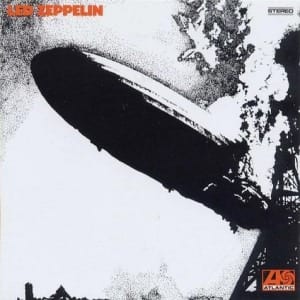
- America
- US – 9,300,000
- Canada – 1,025,000
- Argentina – 120,000
- Asia
- Japan – 440,000
- Oceania
- Australia – 190,000
- New Zealand – 40,000
- Europe – 3,900,000
- UK – 1,130,000
- France – 500,000
- Germany – 500,000
- Italy – 370,000
- Spain – 340,000
- Sweden – N/A
- Netherland – 190,000
- Switzerland – 70,000
- Austria – 50,000
- Finland – N/A
- World – 15,800,000
Led Zeppelin II (1969)
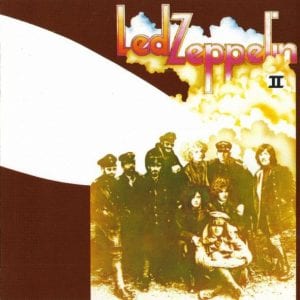
- America
- US – 13,200,000
- Canada – 1,480,000
- Argentina – 130,000
- Asia
- Japan – 640,000
- Oceania
- Australia – 310,000
- New Zealand – 60,000
- Europe – 4,940,000
- UK – 1,580,000
- France – 580,000
- Germany – 630,000
- Italy – 530,000
- Spain – 320,000
- Sweden – N/A
- Netherland – 240,000
- Switzerland – 80,000
- Austria – 60,000
- Finland – N/A
- World – 21,900,000
Led Zeppelin III (1970)

- America
- US – 7,000,000
- Canada – 820,000
- Mexico – 100,000
- Argentina – 150,000
- Asia
- Japan – 540,000
- Oceania
- Australia – 250,000
- New Zealand – 50,000
- Europe – 3,680,000
- UK – 1,240,000
- France – 450,000
- Germany – 450,000
- Italy – 340,000
- Spain – 240,000
- Sweden – N/A
- Netherland – 180,000
- Switzerland – 60,000
- Austria – 50,000
- Finland – N/A
- World – 13,700,000
Led Zeppelin IV (1971)

- America
- US – 23,750,000
- Canada – 2,740,000
- Argentina – 210,000
- Asia
- Japan – 850,000
- Oceania
- Australia – 670,000
- New Zealand – 120,000
- Europe – 6,580,000
- UK – 1,980,000
- France – 840,000
- Germany – 920,000
- Italy – 630,000
- Spain – 450,000
- Sweden – N/A
- Netherland – 270,000
- Switzerland – 130,000
- Austria – 90,000
- Finland – N/A
- World – 36,800,000
Houses Of The Holy (1973)

- America
- US – 12,000,000
- Canada – 1,320,000
- Argentina – 130,000
- Asia
- Japan – 450,000
- Oceania
- Australia – 220,000
- New Zealand – 40,000
- Europe – 2,670,000
- UK – 610,000
- France – 370,000
- Germany – 400,000
- Italy – 290,000
- Spain – 220,000
- Sweden – N/A
- Netherland – 130,000
- Switzerland – 50,000
- Austria – 50,000
- Finland – N/A
- World – 17,700,000
Physical Graffiti (1975)
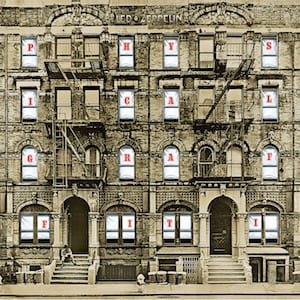
- America
- US – 8,450,000
- Canada – 850,000
- Argentina – 100,000
- Asia
- Japan – 360,000
- Oceania
- Australia – 230,000
- New Zealand – 45,000
- Europe – 2,460,000
- UK – 775,000
- France – 220,000
- Germany – 425,000
- Italy – 260,000
- Spain – 175,000
- Sweden – N/A
- Netherland – 75,000
- Switzerland – 40,000
- Austria – 35,000
- Finland – N/A
- World – 13,400,000
Presence (1976)

- America
- US – 4,000,000
- Canada – 360,000
- Argentina – 50,000
- Asia
- Japan – 370,000
- Oceania
- Australia – 150,000
- New Zealand – 30,000
- Europe – 1,790,000
- UK – 420,000
- France – 260,000
- Germany – 260,000
- Italy – 190,000
- Spain – 160,000
- Sweden – 50,000
- Netherland – 60,000
- Switzerland – 40,000
- Austria – 20,000
- Finland – N/A
- World – 7,300,000
In Through The Out Door (1979)

- America
- US – 7,350,000
- Canada – 710,000
- Argentina – 130,000
- Asia
- Japan – 345,000
- Oceania
- Australia – 180,000
- New Zealand – 40,000
- Europe – 1,850,000
- UK – 450,000
- France – 210,000
- Germany – 320,000
- Italy – 210,000
- Spain – 180,000
- Sweden – 30,000
- Netherland – 60,000
- Switzerland – 30,000
- Austria – 20,000
- Finland – N/A
- World – 11,500,000
Coda (1982)
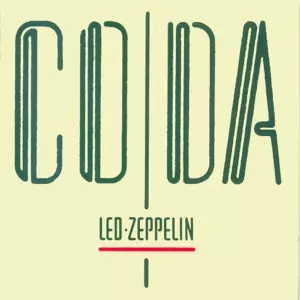
- America
- US – 1,900,000
- Canada – 210,000
- Asia
- Japan – 170,000
- Oceania
- Australia – 75,000
- New Zealand – 20,000
- Europe – 810,000
- UK – 175,000
- France – 140,000
- Germany – 135,000
- Italy – 90,000
- Spain – 45,000
- Sweden – 20,000
- Netherland – 20,000
- Switzerland – 20,000
- Austria – 10,000
- Finland – N/A
- World – 3,400,000
Original Album Sales – Comments
1969 Led Zeppelin I – 15,800,000
1969 Led Zeppelin II – 21,900,000
1970 Led Zeppelin III – 13,700,000
1971 Led Zeppelin IV – 36,800,000
1973 Houses Of The Holy – 17,700,000
1975 Physical Graffiti – 13,400,000
1976 Presence – 7,300,000
1979 In Through The Out Door – 11,500,000
1982 Coda – 3,400,000
No need to comment much as numbers speak by themselves. A very impressive pattern of sales, especially for their first 5 albums, or even 6 when one considers that Physical Graffiti is a double album. At 36,8 million Led Zeppelin IV is firmly established as one of the very best selling albums ever on its own, whilst Led Zeppelin II comes second with 21,9 million copies. Houses Of The Holy at 17,7 million, Led Zeppelin I at 15,8 million, Led Zeppelin III at 13,7 million and Physical Graffiti at 13,4 million rank behind those two.
The softest part of their catalogue relates to their later material, even though Presence and especially In Through The Out Door achieved good sales. Coda is included above but it wouldn’t really be fair to classify it as a proper studio album. In fact, it is listed here to provide you more information but will be added to Orphan Album tally.
As far as worldwide sales are concerned, North America is by far their biggest market. Those 9 albums combined for 96,9 million copies sold there, a sizable 68% of their overall results. UK, Japan, Germany and France are – not surprisingly – amongst their best markets in absolute terms. In relative terms, however, Oceania and parts of Scandinavia are up there, albeit with smaller total sales due to their market’s size.
All told, the above 9 albums managed to sell a breathtaking 142,6 million combined. But their appeal doesn’t quite stop there. And that is what comes next.
Physical Singles Sales
While not their strongest point, Led Zeppelin still sold a few million singles that are -like everything else- worth quoting.
As a reminder, the weighting is done with a 10 to 3 ratio between one album and one physical single.
Led Zeppelin I (1969) – 75,000 equivalent albums
Good Times Bad Times – 250,000
Led Zeppelin II (1969) – 750,000 equivalent albums
Whole Lotta Love – 2,500,000
Led Zeppelin III (1970) – 225,000 equivalent albums
Inmigrant Song – 750,000
Led Zeppelin IV (1971) – 300,000 equivalent albums
Black Dog – 650,000
Rock And Roll – 350,000
Houses Of The Holy (1973) – 225,000 equivalent albums
Over The Hill And Far Away – 250,000
D’yer Maker – 350,000
The Ocean – 150,000
Physical Graffiti (1975) – 120,000 equivalent albums
Trampled Under Foot – 400,000
Presence (1976) – 30,000 equivalent albums
Candy Store Rock – 100,000
In Through The Out Door (1979) – 150,000 equivalent albums
Fool In The Rain – 500,000
Orphan Album – 30,000 equivalent albums
Travelling Riverside Blues, Baby Come On Home & Whole Lotta Love (reissue) – 100,000
Digital Singles Sales
With an estimated 32 million downloads sold worldwide, Led Zeppelin have also achieved remarkable numbers in this territory.
As a reminder, the weighting is done with a 10 to 1,5 ratio between one album and one digital single.
Led Zeppelin I (1969) – 773,000 equivalent albums
Good Times Bad Times – 1,950,000
Remaining tracks – 3,200,000
Led Zeppelin II (1969) – 974,000 equivalent albums
Whole Lotta Love – 2,200,000
Ramble On – 2,100,000
Remaining tracks – 2,190,000
Led Zeppelin III (1970) – 548,000 equivalent albums
Immigrant Song – 1,650,000
Remaining tracks – 2,000,000
Led Zeppelin IV (1971) – 1,329,000 equivalent albums
Stairway To Heaven – 4,050,000
Black Dog – 1,350,000
Rock And Roll – 1,150,000
Remaining tracks – 2,310,000
Houses Of The Holy (1973) – 414,000 equivalent albums
Over The Hill And Far Away – 600,000
D’yer Maker – 550,000
Remaining tracks – 1,610,000
Physical Graffiti (1975) – 470,000 equivalent albums
Kashmir – 1,750,000
Remaining tracks – 1,380,000
Presence (1976) – 84,000 equivalent albums
Remaining tracks – 560,000
In Through The Out Door (1979) – 146,000 equivalent albums
Remaining tracks – 970,000
Coda (1982) – 48,000 equivalent albums
Remaining tracks – 330,000
Orphan Album – 15,000 equivalent albums
Remaining tracks – 100,000
Streaming Sales
Below table lists Spotify streaming of all songs from the albums we are studying. The Comprehensive Streaming is reached by multiplying Spotify figures by 68/26. In fact, as shown in IFPI 2015 Report, there were 68 million paying subscribers to all streaming platforms by the end of 2015. While the exact count of Spotify paying subscribers by the end of 2015 is unknown, that figure reached 20 million in June 2015 and 30 million in March 2016, thus an estimated 26 million is used as of the end of 2015.
The equivalent album sales is the division of the comprehensive streaming figure by 1500 as it is now the norm in the new industry model.
Streaming Part 1 – Debut and quick consolidation
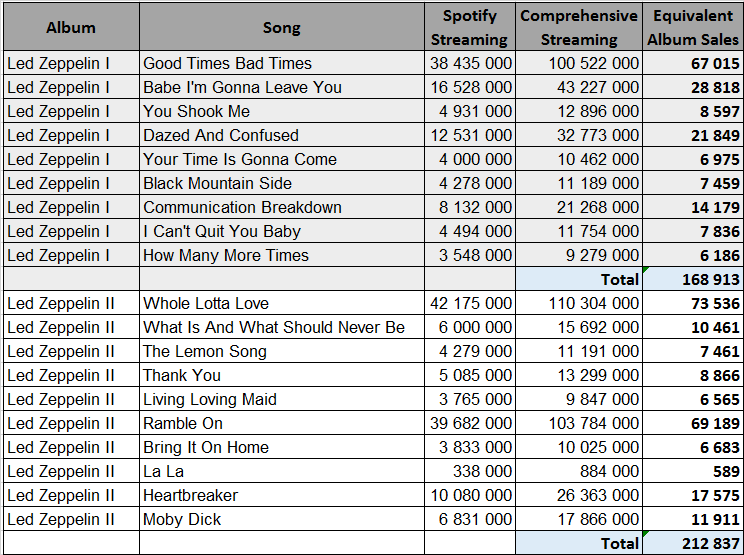
Each Good Times Bad Times, Whole Lotta Love and Ramble On are strong streaming hits around 40 million a piece. With the exception of La La that is available only on a minor version, each track of those two albums tops 3,5 million streams confirming the overall strength of the band records.
While 169,000 and 213,000 album sales equivalent may pale in comparison to those LPs respective sales in album format, this is still in relative terms quite high numbers for such catalog albums.
Streaming Part 2 – Their finest hour
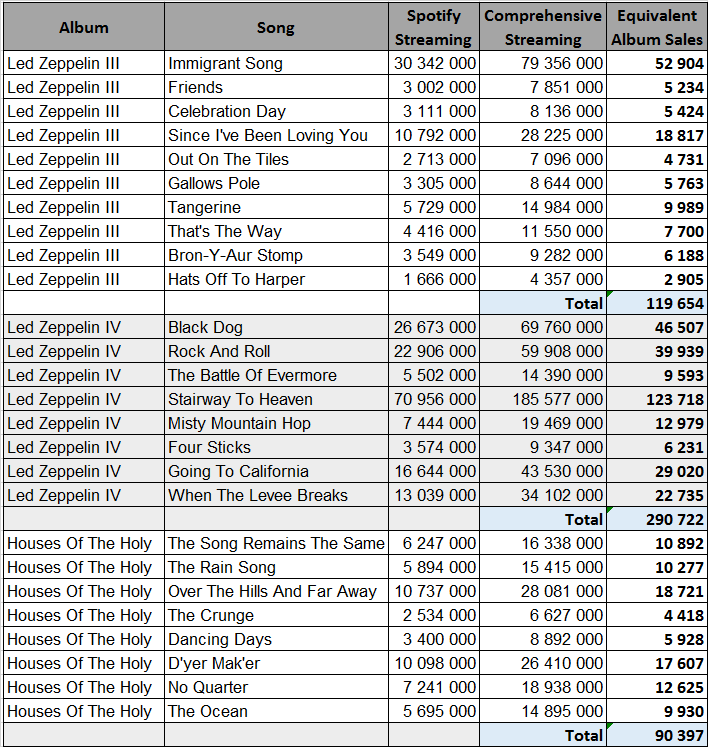
Streaming numbers confirm what we knew about Led Zeppelin discography. Their first three albums have always been close sales-wise with the second volume leading the pack. It does so because it owns two big hits while I and III have one each – Immigrant Song for this latter album. Just like the first two albums, III entire track list gets relevant plays.
The band big hit yet fits into IV album. Stairway To Heaven is one of the very biggest 40+ years old tracks from Spotify at over 70 million listening’s. Four more IV songs are well over 10 million despite the album containing only 8 songs in total. Within’ a few weeks the album sales equivalence of IV streams will reach the 300,000 units barrier.
Houses Of The Holy desperately misses a large hit but all its songs are still quite relevant. This concludes on a very rare pattern of an album having a ratio of only 4 between its biggest track and its weakest.
Streaming Part 3 – Mixed results and last era
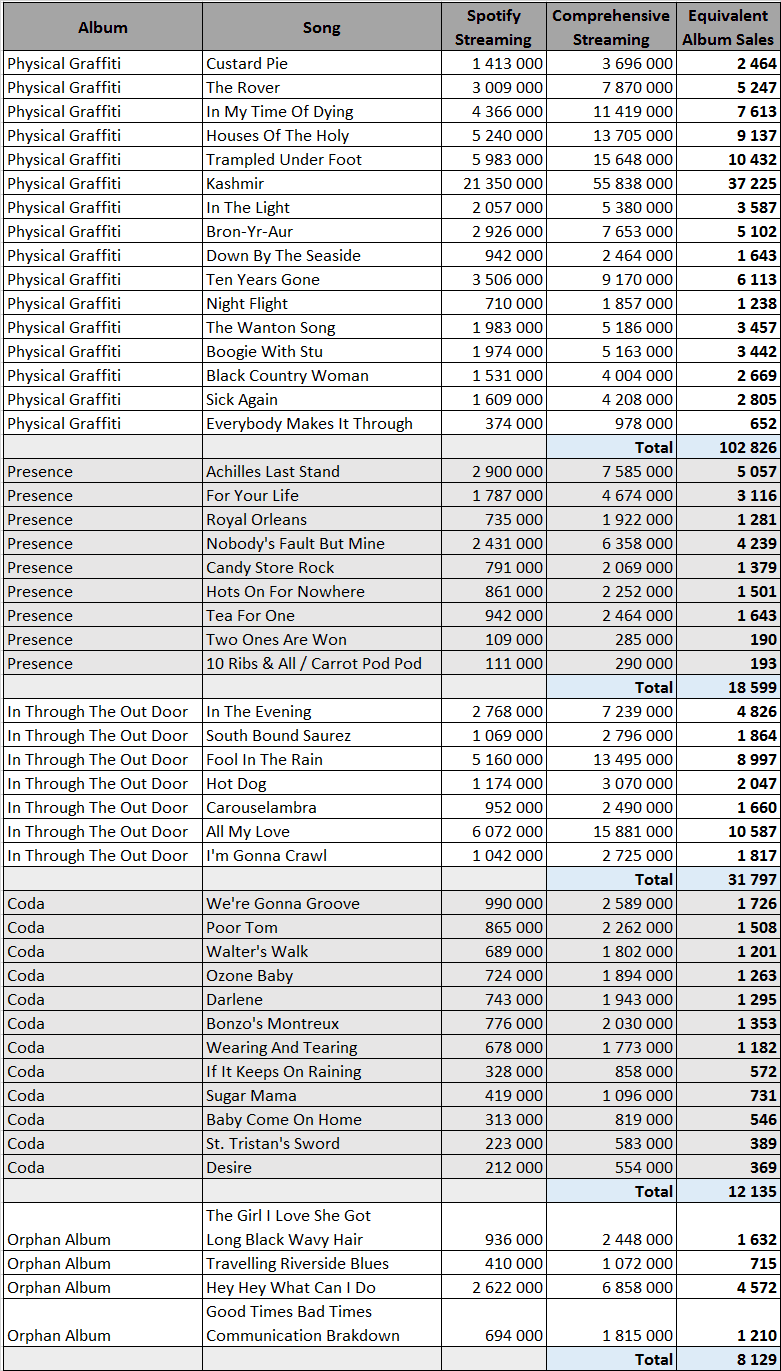
It may sound a bit harsh to say so but for the general public there isn’t that much to retain from the classic rock band latter years except Kashmir.
The lower catalog sales of all those albums, with only Physical Graffiti maintaining some momentum, are perfectly explained by all those results.
Full Length related records Sales
While it mostly happened later into their career, Led Zeppelin have put out a string of compilations and live albums over the past two decades. All of them propelled by the inclusion of their biggest classic songs, which will make up for the vast majority of their subsequent sales. Once again, let’s check all figures.
Full Length Migration Part 1 – Live Albums & Music Videos
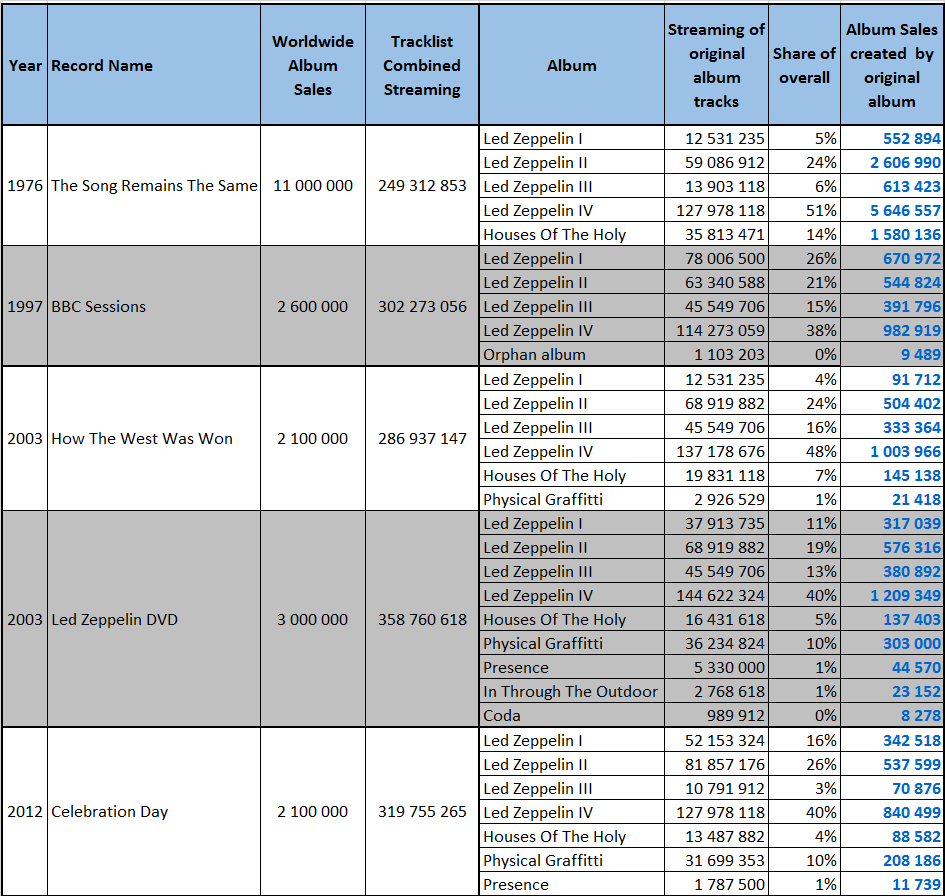
If you read carefully, you will notice how it works. Celebration Day, for example, sold 2,25 million copies in its multiple formats and combinations released, some of which were DVD/Blu Ray only. All versions of its tracklisting achieved nearly 320 million stream on Spotify platform.
The second part of the table shows, at the right side, how many streams are coming from each original studio album, the respective percentage and the final generated sales to be added to each one of those original studio albums.
It is no surprise to see Led Zeppelin 4 as their dominant album for all those records, with a share around 40% of the total streams and therefore a massive 9,5 million sales generated out of the near 21 million those sets sold combined. Led Zeppelin I, Led Zeppelin II and Physical Graffiti all get a decent share in the final percentages. All albums issued in the latter part of their career represent a fairly weak source of sales among those releases.
As an overall note it must be highlighted those figures are especially strong. Led Zeppelin DVD is one of the biggest selling music DVD ever, same for The Song Remains The Same in the live album category.
Full Length Migration Part 2 – Vital compilations
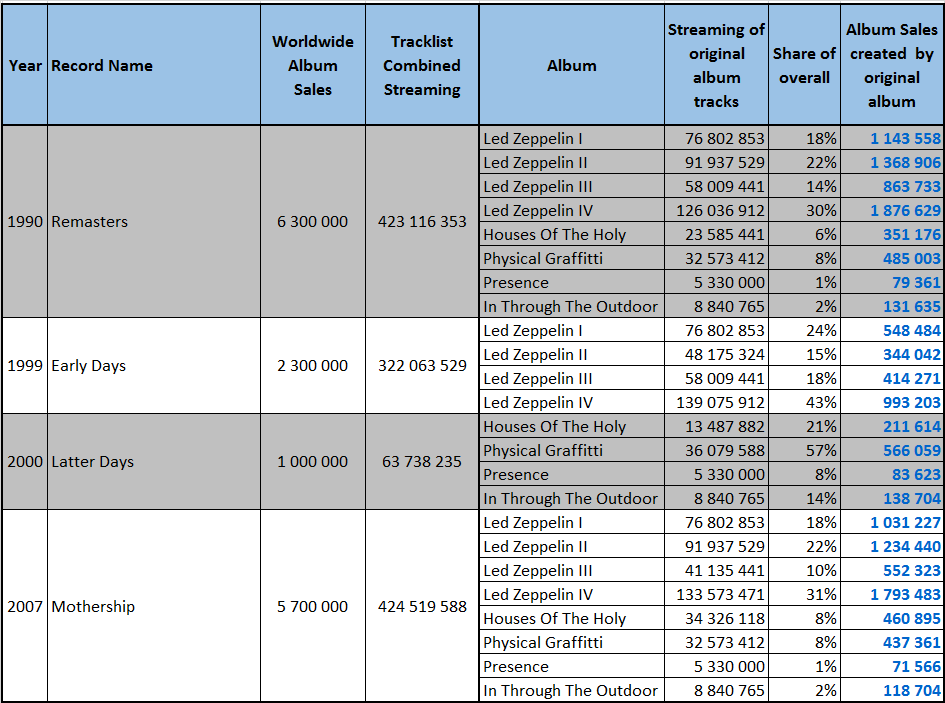
Ever since Remasters (released in 1990), compilations have been almost the norm for Led Zeppelin, after more than two decades of being heavily reluctant to them. This compilation came out in that year only to be replaced by Early Days/Latter Days in 1997 and 1999 respectively, and eventually 2007 set Mothership which has now become their definitive collection of songs. Those packages sold a combined a 15 million worldwide, kind of diminishing their studio albums’ back catalogue sales during the same time frame.
Led Zeppelin IV is the main generator of sales for both Mothership and Remasters as well as for Early Days, whilst the first three albums are ranked just behind. Their last four studio albums from Houses Of The Holy to In Through The Out Door haven’t created as much value as they added very little to their still-to-come final CSPC’s numbers.
Full Length Migration Part 3 – Box Sets Compilations

Here we have The Best Of Led Zeppelin, which was nothing but Early Days and Later Days merged into a double box set that sold more 3 million copies and somehow prevented Latter Days from reaching better figures. Thus, it’s sales are doubled into each individual album as this was a 2CD package rather than a stand-alone compilation. The 500,000 units selling The Complete Studio Recordings appears amongst the very best selling title in its league. As it contained the full original studio albums, all its sales are awarded to each of those albums. Boxed Set and Boxed Set 2 add an extra 4,2 million combined.
Led Zeppelin Career CSPC Results
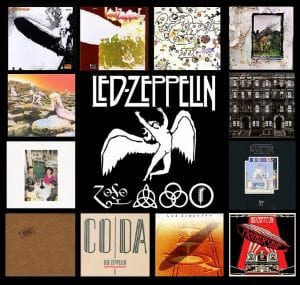
So, after checking all figures, what’s the most successful album by Led Zeppelin and how many overall equivalent albums sales have they achieved? Well, at this point we barely need to do the addition of all figures defined all over this article!
In the following results table, all categories display figures in equivalent album sales. If different, pure sales are listed between parentheses.
As a reminder:
- Studio Album: sales of the original album
- Other Releases: sales of compilations generated thanks to the album
- Physical Singles: sales of physical singles from the album (ratio 3/10)
- Download Singles: sales of digital singles from the album (ratio 1,5/10)
- Streaming: equivalent album sales of all the album tracks (ratio 1/1500 for Audio stream and 1/6750 for Video stream)
Artist career totals
See where the artist ranks among remaining singers
Led Zeppelin is often ranked with the likes Metallica and AC/DC, meaning bands enjoying large catalog sales thanks to the lack of proper compilation albums. This is just untrue with a huge 44 million sales of such records. The fact those sales got spread over several compilations, box sets, live albums and strong music videos concludes on the absence of a very big selling greatest hits, but their overall total is strong.
Out of this total, Led Zeppelin IV is easily the main contributor and as such got fairly rewarded nearly 40% of those sales. If its single segment accounts for less than 1,5 million units all formats considered, the full length records sold on the back of Led Zeppeling IV songs amount for a gigantic 57 million units. Overall this 1971 blockbuster cracks Nirvana‘s Nevermind which was the leading CSPC album out of all those which got studied so far.
While such outstanding results may eclipse the discography of many acts, the rest of Led Zeppelin catalog is equally impressive. In fact, each of their 8 studio albums generated the average of 24,55 million equivalent album sales. If some artists did so over a 3-4 albums discography, doing it over a 8-albums list is massive.
All in all, the cumulative tally of Led Zeppelin is up to 200,5 million album sales equivalent. You can clear all your doubts, Led Zeppelin is definitely in the A-League of all-time top sellers.
As usual, feel free to comment and / or ask a question!
Sources: IFPI, Spotify, Chartmasters.org.
We have more for you
… Led Zeppelin‘ streaming masters analysis
… checking out the upcoming artists or even voting for them!










